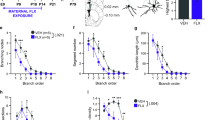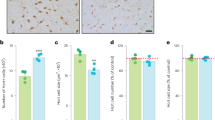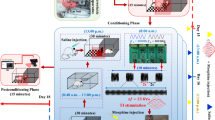Abstract
WHEN guinea pigs are exposed continuously to high morphine concentrations, tolerance and physical dependence develop within a few days in both the central nervous system (CNS) and the myenteric plexus. In the plexus morphine tolerance is associated with subsensitivity to the inhibitory catecholamines and supersensitivity to the excitatory neuro-transmitter serotonin (5-hydroxytryptamine, 5-HT)1,2. We have investigated the following questions about these phenomena, (a) After opiate withdrawal in animals made tolerant and dependent, would the altered sensitivities to neurotransmitters in the plexus return to normal? (b) If so, would loss of tolerance to morphine in the plexus proceed in parallel with loss of subsensitivity to catecholamines and loss of supersensitivity to 5-HT? (c) Would such reversion to normal in the plexus be concurrent with disappearance of CNS indications of tolerance and dependence?
This is a preview of subscription content, access via your institution
Access options
Subscribe to this journal
Receive 51 print issues and online access
$199.00 per year
only $3.90 per issue
Buy this article
- Purchase on SpringerLink
- Instant access to full article PDF
Prices may be subject to local taxes which are calculated during checkout
Similar content being viewed by others
References
Goldstein, A., and Schulz, R., Br. J. Pharmac., 48, 655–666 (1973).
Schulz, R., and Goldstein, A., Nature, 244, 168–170 (1973).
Gibson, R. D., and Tingstad, J. E., J. pharm. Sci., 59, 426–427 (1970).
Rang, H. P., Br. J. Pharmac. Chemother., 22, 356–365 (1964).
Paton, W. D. M., and Zar, M. A., J. Physiol., Lond., 194, 13–33 (1968).
Goldstein, A., in Proc. International Symposia on Alcohol and Drug Research, Toronto, 1973 (Alcoholism and Drug Addiction Research Foundation, Toronto, in the press).
Goldstein, A., and Sheehan, P., J. Pharmac. exp. Ther., 169, 175–184 (1969).
Way, E. L., Loh, H. H., and Shen, F. H., J. Pharmac. exp. Ther., 167, 1–8 (1969).
Cheney, D. L., and Goldstein, A., Nature, 232, 477–478 (1971).
Wei, E., and Loh, H., Nature, 238, 396–397 (1972).
Cochin, J., and Kornetsky, C., J. Pharmac. exp. Ther., 145, 1–10 (1964).
Gianutsos, G., Hynes, M. D., Puri, S. K., Drawbaugh, R. B., and Lal, H., Psychopharmacologia, 34, 37–44 (1974).
Himmelsbach, C. K., Arch. intern. Med., 69, 766–772 (1942).
Martin, W. R., and Jasinski, D. R., J. psychiatr. Res., 7, 9–17 (1969).
Collier, H. O. J., Nature, 205, 181–182 (1965).
Schulz, R., and Cartwright, C., J. Pharmac. exp. Ther. (in the press).
Opitz, K., and Reimann, I., Psychopharmacologia, 28, 165–170 (1973).
Dixon, W. J., J. Am. stat. Assoc., 60, 967–978 (1965).
Author information
Authors and Affiliations
Rights and permissions
About this article
Cite this article
SCHULZ, R., CARTWRIGHT, C. & GOLDSTEIN, A. Reversibility of morphine tolerance and dependence in guinea pig brain and myenteric plexus. Nature 251, 329–331 (1974). https://doi.org/10.1038/251329a0
Received:
Revised:
Issue date:
DOI: https://doi.org/10.1038/251329a0
This article is cited by
-
Morphine tolerance and nonspecific subsensitivity of the longitudinal muscle myenteric plexus preparation of the guinea-pig to inhibitory agonists
Naunyn-Schmiedeberg's Archives of Pharmacology (1988)
-
Ventricular histamine concentrations in naive and morphine-treated rats during acute myocardial ischaemia
Agents and Actions (1988)
-
Cross tolerance between morphine and methionine-enkephalin
Nature (1976)



